Day 1 of a two day Private Tour today. It was a lovely bright and mostly sunny day, warm if a little breezy. We made our way west along the coast to Titchwell to start the day.
On the edge of the car park, we ran into a flock of Long-tailed Tits. They were chasing each other around in the sallows. We could hear a Chiffchaff singing nearby too. The feeders by the visitor centre were rather quiet, with just a Blue Tit, Great Tit and a single Chaffinch this morning.
Out along the main path, the dried-up grazing meadow ‘pool’ held just a Grey Heron and a single Moorhen. The reedbed pool was more productive. The drake Greater Scaup was still present, diving continually, along with a couple of Tufted Ducks. We could hear Bearded Tits calling and all of a sudden a flock of nine flew up out of the reeds and disappeared back out across the reedbed – we saw the back of them as they flew away from us.
A Curlew had earlier circled over the saltmarsh towards Thornham, but now there seemed to be a bit of a commotion over there. We turned to see several Curlews, Redshank and gulls all flying around – everything appeared to have taken to the air. Scanning the sky, we found the culprit – an Osprey was flying over from the direction of Thornham Harbour. We watched as it flew over the saltmarsh, turning and heading over the visitor centre and disappearing behind the trees. A great start to the day!
 Osprey – flew over from the direction of Thornham Harbour
Osprey – flew over from the direction of Thornham Harbour
We carried on along the path, past the Island Hide. A single Grey Plover and a couple of Redshank were on the saltmarsh pool. A Water Rail flew out from the edge of the reeds below us, but turned straight back in to cover, where it started squealing. Then we stopped and scanned the freshmarsh from the bank. There were large numbers of ducks on here today – a lot of Teal, but also a good number of Wigeon and a few Shoveler.
There were quite a few Ruff in the deeper water, feeding in amongst the Teal. One of the grassy islands was full of Golden Plover, looking bright with their golden-spangled upperparts catching the morning sunshine. A single Bar-tailed Godwit was preening nearby – we had a good look at it through the scope, admiring its more strongly marked upperparts and slightly upturned bill, compared to all the Black-tailed Godwits further back.
The muddier edges of the islands held quite a few Dunlin and we started to work our way through to see if we could find something else with them. All the Golden Plover took off and a Little Stint flew in and landed in the water just behind some of the Dunlin. We were just having a good look at it when everything took flight. Through the whirling flocks we could see a larger bird approaching and a Peregrine flew in and landed on one of the islands in front of Parrinder Hide.
 Peregrine – this juvenile landed on the freshmarsh
Peregrine – this juvenile landed on the freshmarsh
The Peregrine was a juvenile and seemed in no hurry to go anywhere. The waders flew round for a while and eventually landed over on the reedbed side of the freshmarsh, as far as they could get from the Peregrine. We scanned through them again and found a Curlew Sandpiper. It gradually came back a bit closer to the path as the birds relaxed a little, at which point we had it side by side with a Dunlin. A great comparison, the Curlew Sandpiper was noticeably a little larger with a slightly longer bill and cleaner, paler underparts. A second Curlew Sandpiper was further over with more Dunlin.
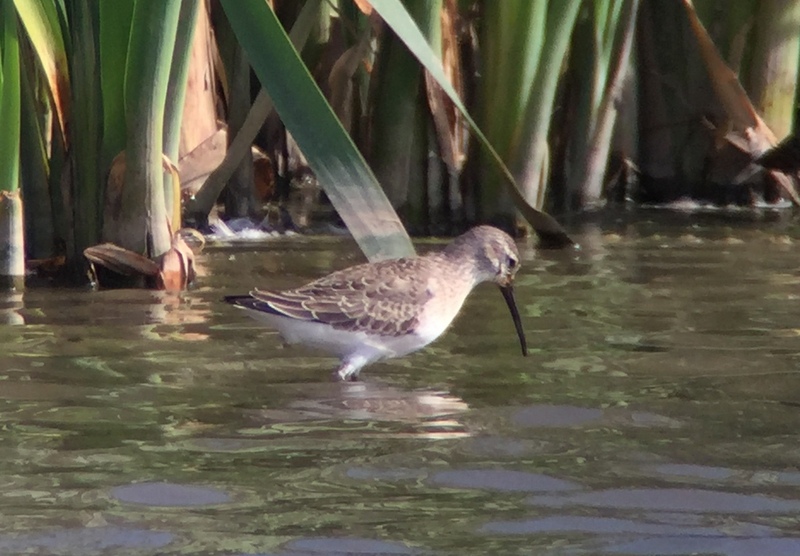 Curlew Sandpiper – at least two were on the freshmarsh again today
Curlew Sandpiper – at least two were on the freshmarsh again today
There were also a couple of Spotted Redshanks now, out in the middle of the water, paler than the Common Redshanks, silvery-grey above and whiter below. One of the Spotted Redshanks had gone to sleep but, through the scope, we could see the other’s longer, needle fine bill. Three more Bearded Tits started calling from the reeds below the path a little further along and then flew past us, back towards Island Hide.
By the time we got round to Parrinder Hide, the Peregrine had flown off. But there was still a distinct lack of birds in front of the hide as a consequence of its earlier presence. Further over, on the far side of the island, we found the Little Stint again, feeding with a couple of Dunlin. We had a good look round, but we couldn’t find any sign of the Pectoral Sandpiper which has been here for the past few days.
 Curlew – there were several on the Volunteer Marsh
Curlew – there were several on the Volunteer Marsh
From the other side of the Parrinder Hide, we could see several Curlews out on the Volunteer Marsh, but not much else today. A single Bar-tailed Godwit on the far side walked down towards the channel by the main path, so we headed round there for a better look. A Little Egret and a couple of Redshanks were feeding along the channel, but the Bar-tailed Godwit walked quickly away as we approached along the path.
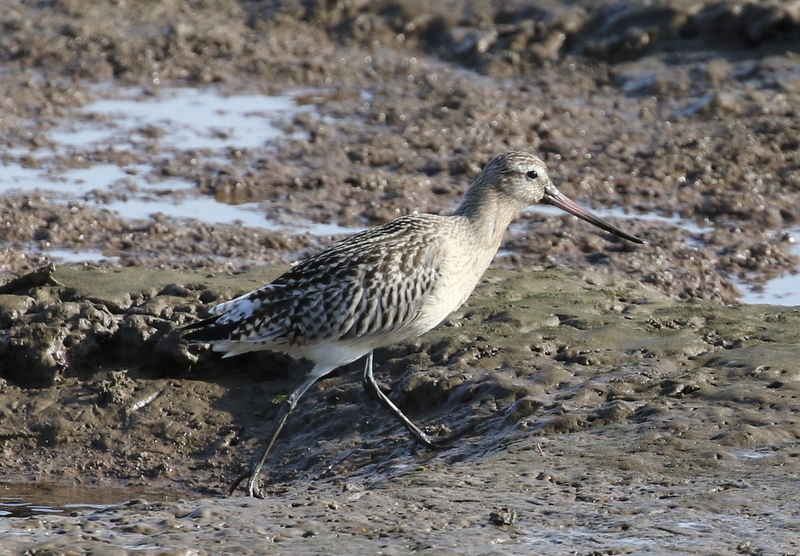 Bar-tailed Godwit – on the Volunteer Marsh, by the path briefly
Bar-tailed Godwit – on the Volunteer Marsh, by the path briefly
With the sun shining, we decided to make our way out towards the beach. As we walked up to the tidal pools, we heard a Kingfisher call and saw it fly into the bushes along bank straight ahead of us. Moving a little way further along the path, we could see where it was perched. We watched it for a while, as it flew between various branches overhanging the water, flashing electric blue as it went.
There were a few waders on the tidal pools today too, including a couple more Grey Plover and a little group of roosting smaller waders – four Ringed Plovers, a Turnstone and a Dunlin. Further along, just behind the beach, a lone Black-tailed Godwit was feeding in the shallows close to the path, a nice opportunity to compare with the Bar-tailed Godwit we had just seen. Looking out the other side, over the saltmarsh towards Thornham Point, we could see two Marsh Harriers quartering.
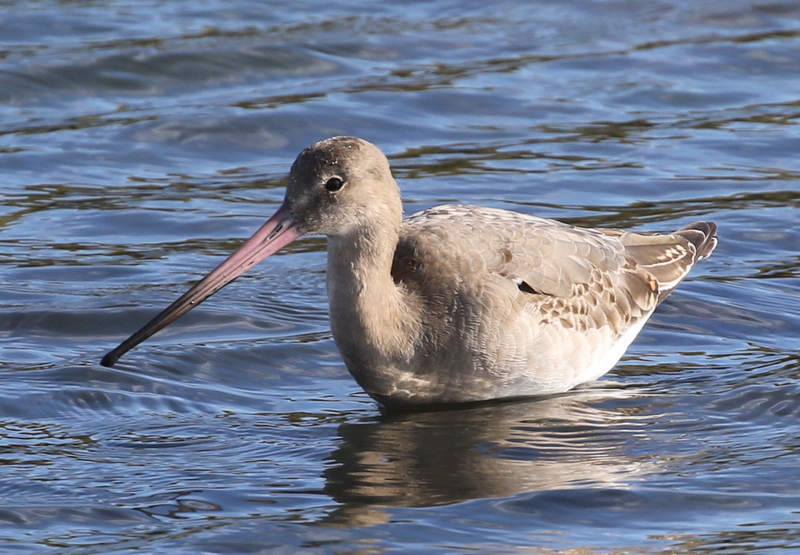 Black-tailed Godwit – feeding by the path on the tidal pools
Black-tailed Godwit – feeding by the path on the tidal pools
The tide was out so there were a few waders on the beach. Down on the mussel beds, we could see several small flocks of Knot and quite a few Oystercatchers, as well as more Bar-tailed Godwits. Further along the beach towards Thornham, we could see several diminutive Sanderlings running around on the shoreline.
Looking out to sea, we picked up a couple of Great Crested Grebes and a winter plumage Red-throated Diver. A single Gannet was plunge diving a short way along the coast and a steady stream of other Gannets flew in past us too, heading west, mostly dark slate grey juveniles.
On our way back, we took a detour round via the Meadow Trail. There was a flock of Long-tailed Tits by the junction with the main path, but all we could find with them was a Chiffchaff. However, further along the Meadow Trail we heard the distinctive sound of a Yellow-browed Warbler calling. It called repeatedly, several bursts, but unfortunately remained deep in the sallows. It was a bit windy round here today, which probably didn’t help our chances of seeing it. Still, it was nice to hear.
We continued on round to Patsy’s Reedbed, stopping on the way to watch a Reed Warbler clambering around in some elder trees. Patsy’s was rather quiet, apart from a flock of Lapwing and handful of Ruff, but we did find a Common Snipe on there as we carried on round the path to the Autumn Trail. A little group of Swallows flew through west, migrants on their way now.
There had been a few smaller waders in the far corner of the freshmarsh viewed from the other side, but they had gone by the time we got round to the end of the Autumn Trail. We could see three Spotted Redshanks roosting over by the fence and heard a Greenshank calling. Another two Bearded Tits flew past and disappeared into the reeds.
There were lots of dragonflies out enjoying the sunshine today. Common Darters were everywhere, basking on the boardwalks, signs and handrails. A few Migrants Hawkers were hunting, mostly in the trees where they could find some shelter from the wind.
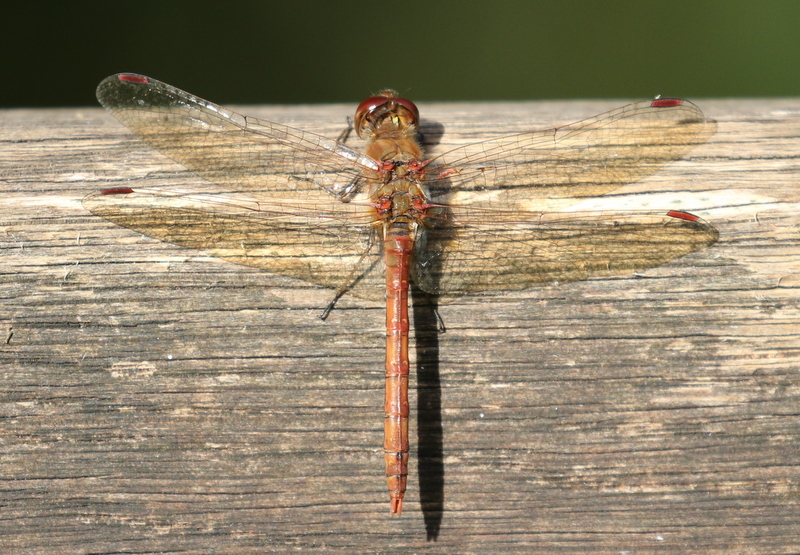 Common Darter – lots were enjoying the autumn sunshine today
Common Darter – lots were enjoying the autumn sunshine today
After lunch, we made our way back along the coast to Brancaster. Parking at the end of Beach Road, we walked out onto the sand and turned east. Immediately, we could see a little crowd gathered further ahead of us, in the edge of the dunes. We made our way along there and were soon enjoying stunning close-up views of a Hoopoe.
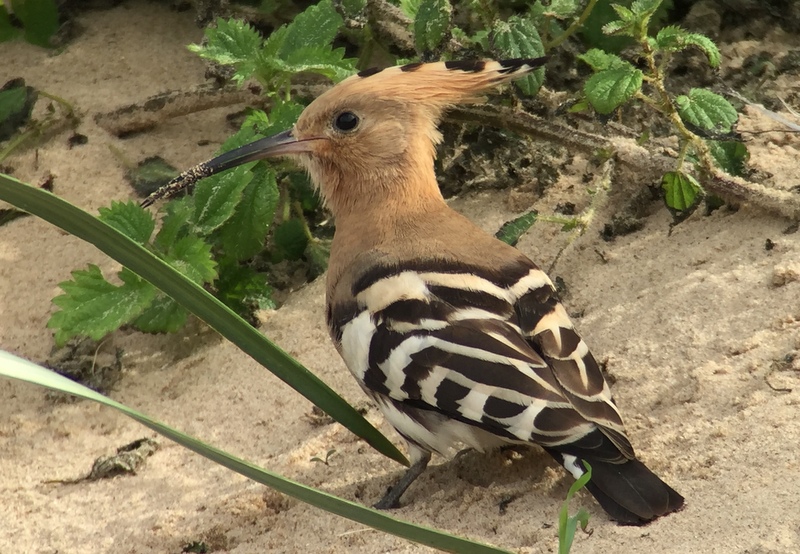 Hoopoe – feeding in the dunes by Brancaster golf course
Hoopoe – feeding in the dunes by Brancaster golf course
The Hoopoe has probably been here for over a week now, but has been showing well for the last couple of days. It seemed relatively unconcerned by the presence of so many people and was happily feeding in the sand, probing vigorously around with its long bill at the base of the plants growing in the dunes. It seemed to be finding lots of caterpillars. We watched the Hoopoe for some time, before it suddenly flew up over the dunes and out towards the golf course (it also likes to feed on the greens!).
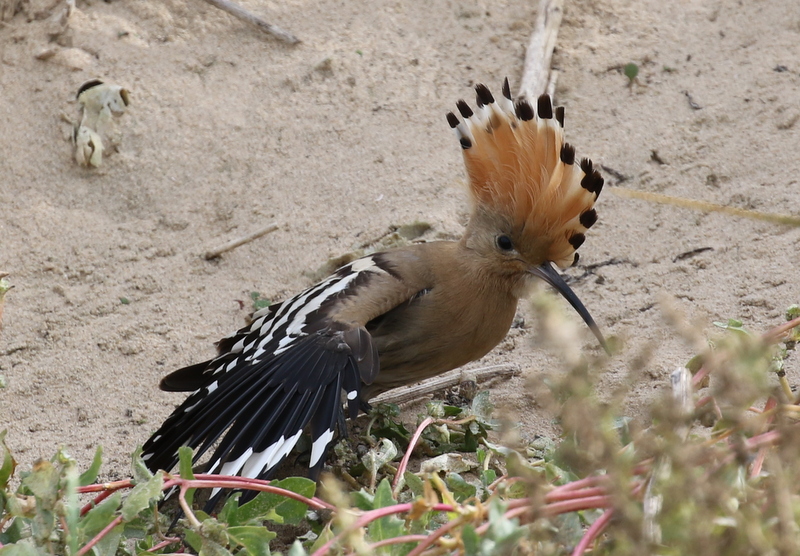 Hoopoe – stunning with its crest raised
Hoopoe – stunning with its crest raised
Next, we turned our attention to the sea. There were several Sandwich Terns feeding in the channel between the beach and Scolt Head. Behind them, more Sandwich Terns were loafing around on a sandy point. When they all suddenly took flight, we looked over to see a larger, dark, blackish bird flying straight into the flock. It was an Arctic Skua – a smart pale phase adult. It chased half-heartedly after the terns for a while, before drifting off around the north end of Scolt Head where we could see it distantly joined by a second Arctic Skua.
Returning to the car, we made our way back east along the coast and called in at Holkham. It felt like the wind had dropped a little while we were at Brancaster, but it seemed to have picked up again here and become a little stronger. It was quiet at first walking west through the trees. Salt’s Hole held a single Wigeon with the Mallard and three Little Grebes. A couple of Common Buzzards circled over the pines together with a Kestrel.
We had a quick look from the boardwalk by Washington Hide but the grazing marshes here were quiet and the sycamores behind were being lashed by the wind, so we carrier on west. We were almost at the crosstracks, when we stopped to check out the bushes in a sheltered corner out of the wind. Suddenly there was a rush of wings and a Hobby swooped in low, just over the bracken, and grabbed a dragonfly not 10 metres in front of us! It was all a bit of a blur as it came past so close, but we watched it as it climbed back up eating its prey. Great stuff!
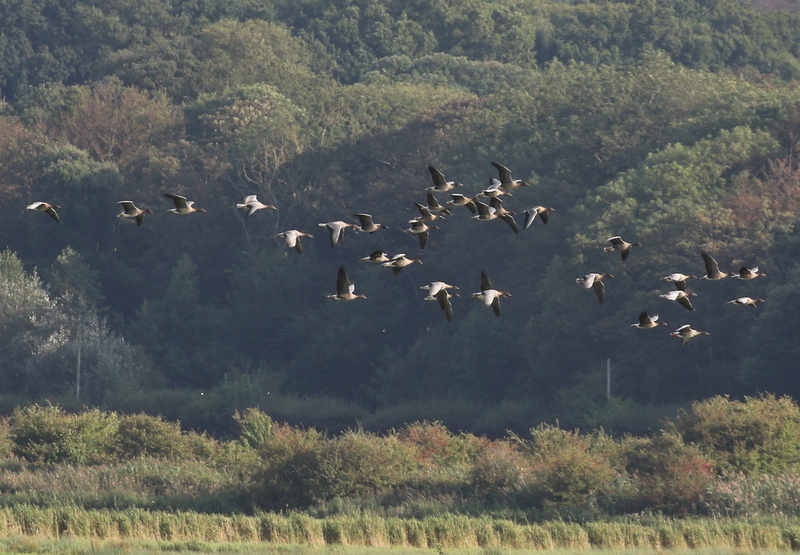 Pink-footed Geese – flying in to the pools to bathe
Pink-footed Geese – flying in to the pools to bathe
We could hear Pink-footed Geese calling as we climbed up to Joe Jordan hide, but none were visible at first. Gradually small groups got up from the grazing marshes and flew round to the pools away to our left to bathe. The numbers gradually increased until there was a decent sized flock on the water, with birds starting to drift back to the marshes.
A Grey Partridge called from the grass below the hide and we could see it creeping through the vegetation. A Jay flew across and landed in the top of a hawthorn, carrying an acorn. Several Marsh Harriers circled over or sat perched in the bushes. We could see lots of Cormorants already in the trees, but watched as over 100 flew in to join them, presumably to roost.
However, the highlight was not one but two Great White Egrets which flew in across the grazing marshes. The first continued on east and landed again out of view behind some reeds, but the second circled round and dropped down behind Decoy Wood.
It was time to start making our way back, but just out of the trees to the east of the crosstracks we came across a tit flock. We could hear Goldcrests and Coal Tits calling on the edge of the pines and then a Yellow-browed Warbler started calling from the sallows beyond. The flock was working its way quickly back through the bushes away from us, but we managed to get a couple of views of the Yellow-browed Warbler on its way, before the birds all disappeared towards Bone’s Drift.
That was a nice way to end, so we headed back to the car.
















